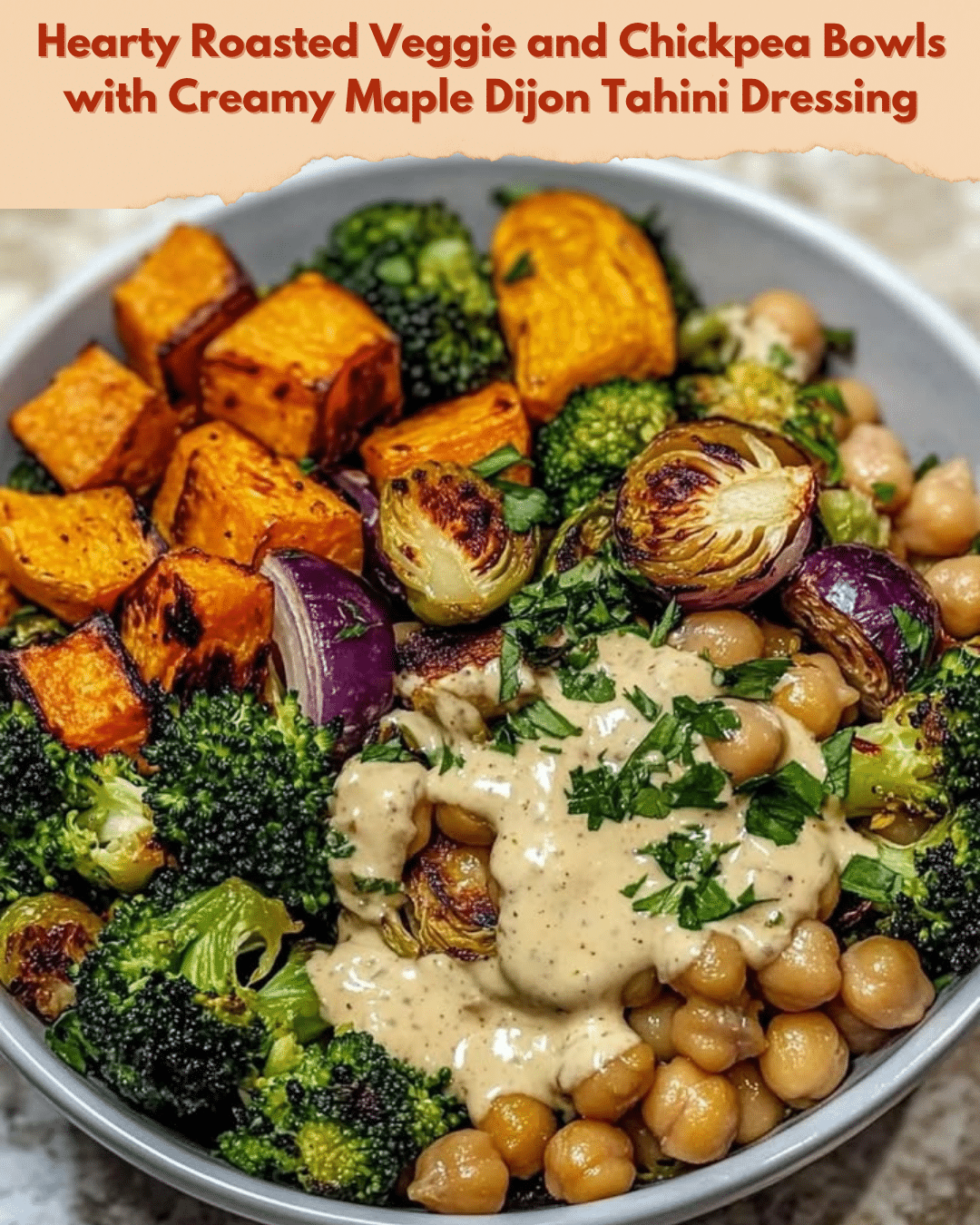Hearty Roasted Veggie and Chickpea Bowls with Creamy Maple Dijon Tahini Dressing: A Deliciously Balanced Meal
Dive into a delicious journey with our Hearty Roasted Veggie and Chickpea Bowls with Creamy Maple Dijon Tahini Dressing. This delightful dish not only appeals to the palate with its rich, savory flavors but also satisfies the need for a nutritious meal that’s packed with plant-based ingredients. Roasted to perfection, the vegetables and chickpeas create irresistible aromas and an inviting presentation.
These bowls are a perfect combination of textures and taste, offering a balance of crunchy roasted veggies, creamy dressing, and hearty chickpeas. The earthy and nutty tahini, blended with sweet maple and zesty Dijon, enhances the dish’s flavor profile, transforming simple ingredients into an exquisite culinary experience. Ideal for a quick weeknight dinner or a lunch that impresses your family and friends, this recipe is sure to become a favorite.
Quick Recipe Highlights
- Flavor Profile: A harmonious blend of savory roasted vegetables and sweet maple-Dijon notes make this a flavorful delight.
- Texture: Enjoy a mix of tender veggies and the crunch of roasted chickpeas, brought together with a creamy dressing.
- Aroma: Experience the rich, nutty scent of tahini paired with the enticing smell of roasted vegetables.
- Visual Appeal: The vibrant colors of fresh veggies and golden chickpeas create an appealing presentation.
- Skill Level Needed: Moderate cooking skills needed for roasting and dressing preparation.
- Special Equipment: A baking sheet and blender are essential for optimal results.
Recipe Overview
- Difficulty Level: While the recipe requires some multitasking for roasting and preparing the dressing, it’s manageable with basic cooking skills.
- Category: This hearty veggie bowl is perfect as a main dish, especially for those following a plant-based or vegetarian diet.
- Cuisine: Drawing inspiration from Mediterranean and Middle Eastern cuisines, this dish delivers a global taste experience.
- Cost: With ingredients like seasonal vegetables, canned chickpeas, and pantry staples, the cost remains reasonable and accessible.
- Season: Best enjoyed year-round but particularly comforting in fall and winter when roasted dishes are craved.
- Occasion: Ideal for both everyday meals and casual dinner parties, impressing guests with its flavorsome harmony.
Why You’ll Love This Recipe
The Hearty Roasted Veggie and Chickpea Bowls with Creamy Maple Dijon Tahini Dressing offer an appealing combination of taste and texture. The roasted vegetables bring out natural sweetness while maintaining a slightly crispy texture, pairing perfectly with the richness of the chickpeas.
Convenience is key in this recipe. With a total cooking time under an hour, it’s perfect for a quick, healthy dinner without sacrificing flavor. The use of easily accessible ingredients means you can whip up this meal without a trip to specialized grocery stores.
Packed with plant-based proteins and fibers, this dish contributes to a balanced diet, making it not only delicious but nourishing as well. Chickpeas provide essential nutrients, while a variety of vegetables boost your intake of vitamins and minerals.
As a visually appealing and tasty option, these bowls are excellent for social gatherings. Their vibrant presentation will captivate guests, making them a conversation starter at any table.
Cost-effectiveness is inherent in this recipe. With many ingredients likely already in your pantry, you can enjoy a gourmet-style meal without a hefty price tag. The recipe is adaptable to suit whatever vegetables you have on hand, reducing waste and saving expense.
Historical Background and Cultural Significance
Originating from the versatile repertoire of Mediterranean cuisine, the use of roasted vegetables and tahini blurs the line between tradition and modern culinary approaches. The Arab world, particularly Lebanon, features tahini and chickpeas prominently in their dishes, offering a rich layer of historical context to this recipe.
Culturally, the dish is a nod to communal dining traditions, where shared meals foster connection and warmth. Such dishes have always emphasized fresh, local produce, a philosophy that’s now universally echoed in sustainable farming and eating.
Over time, the recipe has evolved, adapting to global palates and dietary preferences. Originally, more exotic spices might have flavored this dish, but today it has taken on a more international garb with ingredients like Dijon mustard.
There are regional spins on similar bowls across the globe, each reflecting culinary heritage while incorporating locally available vegetables, making it a truly versatile option no matter where you are.
Ingredient Deep Dive
Chickpeas, also known as garbanzo beans, have been a staple in diets around the world for centuries, originating in the Mediterranean and Middle East. They are celebrated for their high protein and fiber content, essential for plant-based diets, aiding digestion and maintaining heart health.
When selecting chickpeas, opt for those that are firm and uniform in color. If using canned chickpeas, rinse them thoroughly to reduce sodium content. Store dried chickpeas in a cool, dry place, sealed in an airtight container, to maximize shelf life. Substitutions like cannellini beans can be used if chickpeas aren’t available.
Tahini, a paste made from sesame seeds, offers a unique nutty flavor and creamy texture. Historically significant in Middle Eastern cuisines, it’s rich in healthy fats, protein, and essential vitamins, making it a nutritious addition to any meal.
Choose tahini that’s smooth and of light color, indicating well-toasted sesame seeds. Store it in a cool, dark pantry before opening, and refrigerate after opening to maintain freshness. If unavailable, almond butter or peanut butter can serve as suitable substitutes with slight flavor adjustments.
Common Mistakes to Avoid
- Overcrowding the baking sheet can lead to steaming instead of roasting. Spread vegetables evenly for the best results.
- Undercooking chickpeas could result in a less desirable texture. Aim for a slight crispness.
- Skipping the step of drying chickpeas after rinsing leads to a less crispy end product.
- Using old tahini results in a bitter and off flavor. Always taste test before adding to your dressing.
- Under-seasoning mistakes are common; don’t be shy to taste and adjust the spices as needed.
- Ignoring the oil measurement could lead to either dry vegetables or overly greasy results.
- Neglecting to toss veggies during roasting can lead to uneven cooking and burning.
- Using too much dressing can overwhelm the flavors of the vegetables and chickpeas.
- Keeping the oven door open for too long while checking vegetables lowers the cooking temperature.
- Forgetting to rest the roasted veggies a bit before serving helps flavors meld more effectively.
Essential Techniques
A crucial technique in preparing this recipe is achieving the perfect roast on your vegetables and chickpeas. Proper roasting brings out natural sweetness and adds a satisfying texture. Spread the ingredients out evenly on the baking sheet, preventing crowding that causes steaming.
Mastering the art of making creamy maple Dijon tahini dressing is another key element. Blending the ingredients to achieve a smooth and velvety texture is crucial. Start with lesser liquids and add more as needed to find the perfect balance, aiming to avoid a dressing that’s too runny.
Pro Tips for Perfect Hearty Roasted Veggie Bowls
To enhance the flavors further, consider adding a sprinkle of feta or a squeeze of fresh lemon juice before serving. The acidity cuts through the richness for an even more compelling flavor.
Utilize pre-cut or frozen veggies for a quicker assembly process. While fresh produce might offer slightly better flavor, high-quality frozen options are convenient and nutritious.
Substitute maple syrup with honey for a slightly varied sweetness, balancing the Dijon’s pungency. Taste the dressing as you go to maintain a harmonious blend.
Choose your favorite vegetables, knowing that heartier options like sweet potatoes and carrots elevate the dish. Swap them out seasonally for the freshest taste.
To ensure a clean presentation, slice vegetables uniformly, promoting thorough and even roasting. It also aids in creating an aesthetically pleasing dish.
Keep a close watch on chickpeas near the end of roasting, as they can quickly turn from perfectly crispy to burnt. They require extra vigilance despite their robust texture.
Variations and Adaptations
Regional variations are easily made by incorporating spices or fresh herbs signature to different cuisines. Add cumin and coriander for a Middle Eastern flair, or chili powder and lime for a Mexican twist.
Adapt seasonally by incorporating autumn favorites like butternut squash and Brussels sprouts or summer treasures such as zucchini and bell peppers.
For dietary modifications, replace tahini dressing with a yogurt-based one for those seeking a lighter, lower-fat option.
Flavor variations are unlimited with different vinegar choices in the dressing or through the addition of spice blends.
Transform the texture by switching from roasted to grilled vegetables, adding a smoky element to the dish.
For a modern presentation, layer ingredients in a mason jar for a visually appealing, portable meal option. Utilize contrasting colors for the most striking effects.
Serving and Presentation Guide
When serving, use wide, shallow bowls or plates to display the spectrum of colors within the dish. This approach emphasizes the vibrant ingredients and encourages mixing while eating.
For garnishing, consider fresh herbs such as parsley or cilantro, adding a pop of color and freshness. Sprinkle seeds like sesame for an extra crunch.
Traditional accompaniments like pita bread or couscous can complement the meal, making it more filling and satisfying.
Modern serving suggestions include pairing with cauliflower rice or quinoa for extra protein and texture.
It’s best served slightly warm or at room temperature, allowing the flavors to meld and the dressing to coat the ingredients luxuriously.
Control portions by serving with a large, flat serving spoon or spatula, minimizing spilling and maintaining presentation quality.
Wine and Beverage Pairing
A light, crisp white wine such as Sauvignon Blanc pairs beautifully with the earthy and nutty notes of tahini and the freshness of the vegetables. It cuts through the dish’s richness, offering a balanced palate.
Non-alcoholic alternatives like a sparkling water with a hint of lemon or lime can refresh the palate while enhancing the meal’s flavors.
Herbal teas like chamomile or a light green tea provide a gentle, soothing accompaniment, adding a subtle layer of complexity.
Serving wines slightly chilled or beverages cold complements the dish’s bright flavors, providing contrast to the warmth of roasted ingredients.
For an indulgent experience, offer a wine serving suggestion displayed chicly next to the meal, enhancing the dining atmosphere.
Storage and Shelf Life
Seal leftovers in an airtight container to maintain freshness, refrigerating them for up to three days. Avoid overcrowding the container to prevent sogginess.
Keep dressing separate until serving to prevent the mixture from becoming too saturated. Decide daily how much dressing to use based on personal preference.
Monitor signs of spoilage, such as changes in color or a sour smell, and discard the dish if noticed. Freshness is key to savoring this recipe fully.
To reheat, warm in the oven at a low temperature, maintaining the crispness of vegetables and chickpeas. Microwaving may result in a less desirable texture.
Freezing is not recommended, as the textures of roasted vegetables and chickpeas might alter negatively. Instead, prepare smaller batches for future eats.
Make Ahead Strategies
Prepare the dressing a day in advance, allowing the flavors to develop further. Store it in a tightly sealed container in the refrigerator.
Cut and store vegetables a day before, making assembly quick and stress-free when ready to cook. Separate the ones likely to bruise or become overly moist.
Assemble the bowls without dressing in advance and refrigerate. Dress just before serving to keep vibrancy and natural textures intact.
Reheat pre-roasted vegetables and chickpeas in an oven for a few minutes to restore their crisp texture and warmth.
Introduce fresh elements like herbs or seeds just before serving, refreshing the dish’s flavors and appearance.
Scaling Instructions
When halving the recipe, pay close attention to proportions, especially the dressing, to ensure balanced flavors are maintained.
Doubling or tripling the recipe requires adequate equipment adjustments. Use larger baking sheets to maintain even cooking without overcrowding.
Modify cooking times slightly based on increased quantities, ensuring thorough roasting and proper flavor development without burning.
Consider storage changes when increasing the recipe, providing sufficient containers for leftovers or pre-preparation processes.
Maintain dressing proportions when multiplying the recipe, adjusting as necessary based on taste preferences to create consistent outcomes.
Nutritional Deep Dive
The bowls offer a balanced macro breakdown, rich in carbohydrates from vegetables and chickpeas, proteins primarily from chickpeas and tahini, and healthy fats thanks to the tahini and olive oil.
Packed with micronutrients, they provide essential vitamins and minerals like Vitamin C, fiber, and iron from diverse ingredients.
Vegetables offer antioxidants that combat free radicals, improving overall health and boosting the immune system.
Dietary considerations should include monitoring oil amounts for calorie-conscious eaters, managing portion sizes while ensuring adequacy for energy needs.
Weight management hinges on serving sizes, and the opportunity to adjust caloric intake by altering dressing and oil usage makes it adaptable.
Dietary Adaptations
For a gluten-free adaptation, ensure all dressing components are certified gluten-free, as cross-contamination is possible in processed ingredients.
To achieve a dairy-free dish, avoid any optional cheese toppings, focusing on plant-based options for added texture and flavor.
Make it vegan-friendly by ensuring maple syrup substitutes honey in the dressing, maintaining its plant-based integrity.
A low-carb version could exchange chickpeas for more low-carb vegetables, focusing on greens and non-starchy ingredients.
For keto accommodations, adapt dressing proportions to remain high in fat, and modify chickpea usage to maintain keto macronutrient balance.
For a paleo-friendly option, focus on vinegars approved for paleo diets while maximizing vegetable variety for flavor richness.
Troubleshooting Guide
If encountering texture issues like soggy vegetables, ensure that they are seasoned properly and roasted at adequate heat to encourage caramelization and moisture evaporation.
Balance flavor by adjusting seasoning as needed if the recipe comes across too bland. A sprinkle of salt or a drizzle of acid, such as lemon juice, can rejuvenate flavors.
Temperature problems usually arise from inconsistent roasting methods. Preheating the oven and monitoring time closely can prevent undercooking or overcooking.
Equipment challenges are common when lacking baking sheets, an alternative being to divide the work into smaller batches, preventing overcrowding.
Substituted ingredients require attention to flavor balance, accounting for both contrasting and complementing notes, to avoid overpowering the dish.
Timing concerns can be alleviated with staggered preparation or mise en place, ensuring all components are ready for seamless assembly.
Recipe Success Stories
Among the feedback, readers have consistently praised the dish’s vibrant presentation and engaging flavors, with some exploring added spices for a spiced twist.
Community photos showcase creative garnishing, using various fresh herbs and seeds to customize the bowl’s appearance and taste.
Reader adaptations have introduced protein elements, like grilled chicken or tofu, appending the plant-based protein profile successfully.
Suggestions for variations include flavor infusions with bold spices, introducing freshness and complexity into each bite, shared widely on social media.
Photography tips suggest capturing from above to highlight the dish’s vibrant colors, utilizing neutral backgrounds to draw attention to the ingredients themselves.
Frequently Asked Questions
- Can I substitute maple syrup with honey? Absolutely, though it will alter the flavor slightly. Honey provides a different kind of sweetness, but it pairs well with Dijon mustard.
- How can I make the chickpeas crispier? Pat them dry thoroughly before seasoning, ensuring even oil distribution. Baking them longer at a high temperature can also add additional crunch.
- Is the dressing vegan? Yes, the dressing is naturally vegan. Ensure all ingredients, including the Dijon mustard and syrup, don’t contain animal by-products.
- What’s the best way to store leftovers? Use separate airtight containers for the vegetables, chickpeas, and dressing. Keep them sealed to maintain freshness.
- Can I use a different vinegar in the dressing? Yes, apple cider vinegar or red wine vinegar can be excellent substitutes, each imparting a unique tang.
- How do I prevent the veggies from sticking to the baking sheet? Use parchment paper or a silicone baking mat, and ensure sufficient oil coating on the vegetables.
- Are canned chickpeas okay? Canned chickpeas are convenient and work well. Rinse them thoroughly to remove excess sodium before use.
- How can I intensify the flavors? Additional spices like paprika or cumin can be added to roasted vegetables for more depth. Experimenting with fresh herbs in the dressing can also amplify flavors.
- Is this dish freezer-friendly? Freezing is not recommended due to potential texture changes. It’s best enjoyed fresh or stored for short-term refrigeration.
- Can I make this dish ahead for a party? Absolutely. Prepare all components in advance and combine shortly before serving for maximum freshness and presentation appeal.
Additional Resources
Explore related recipes such as Mediterranean roasted vegetable salads or chickpea stews for complementary meal ideas. Detailed technique guides on roasting different vegetables enhance fundamental skills in creating various dishes.
Ingredient information pages provide further insights into chickpeas, tahini, and spices, elevating culinary knowledge. Equipment recommendations for reliable baking sheets and blenders ensure consistent results, fostering an outstanding cooking experience.
Seasonal variations are explored through lists of ideal produce for diverse times of the year, encouraging sustainability and peak flavor utilization.
Print
Hearty Roasted Veggie and Chickpea Bowls with Creamy Maple Dijon Tahini Dressing
Description
A satisfying and nutritious bowl filled with roasted vegetables and chickpeas, topped with a creamy maple Dijon tahini dressing.
Ingredients
For the Crust:
- 2 cups chopped sweet potatoes
- 1 cup cauliflower florets
- 1 red bell pepper, chopped
- 1 can (15 oz) chickpeas, drained and rinsed
- 2 tablespoons olive oil
- 1 teaspoon smoked paprika
- Salt and pepper to taste
- 1/4 cup tahini
- 2 tablespoons maple syrup
- 1 tablespoon Dijon mustard
- 2 tablespoons lemon juice
Instructions
1. Prepare the Crust:
- Preheat the oven to 400°F (200°C) and line a baking sheet with parchment paper.
- In a large bowl, toss sweet potatoes, cauliflower, red bell pepper, and chickpeas with olive oil, smoked paprika, salt, and pepper. Spread evenly on the prepared baking sheet.
- Roast in the oven for 25-30 minutes, stirring halfway through, until vegetables are tender and golden brown.
- Meanwhile, in a small bowl, whisk together tahini, maple syrup, Dijon mustard, lemon juice, and a splash of water until smooth. Adjust seasoning if necessary.
- Assemble the bowls by dividing the roasted vegetables and chickpeas among four bowls and drizzling with the creamy dressing.
Notes
You can customize the seasonings to taste.





